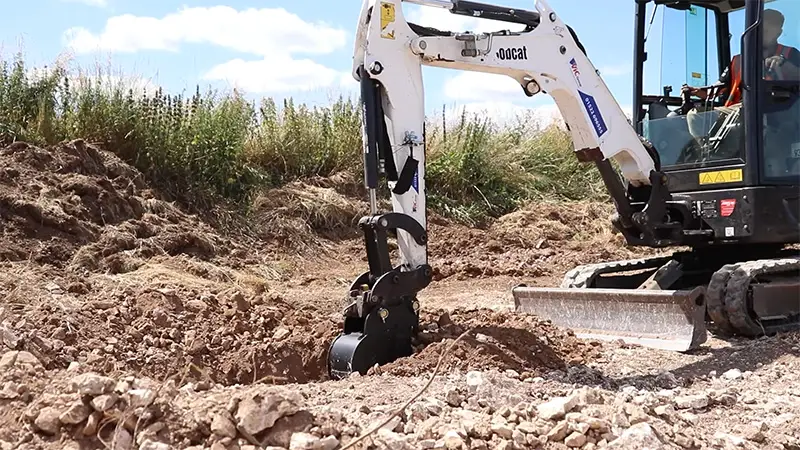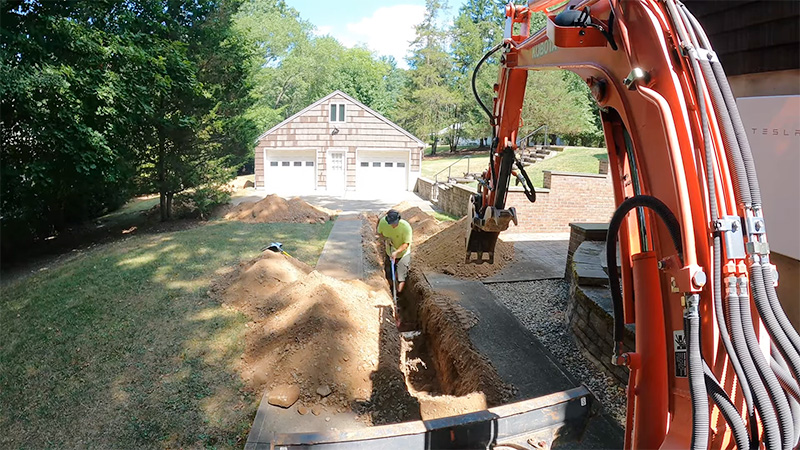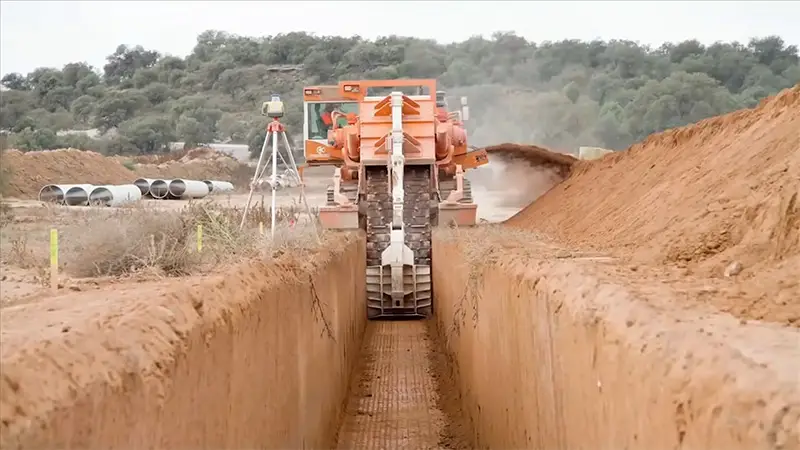When it comes to construction, landscaping, or utility installation projects, one task that often stands out is digging a trench.
Whether it’s for laying pipelines, burying cables, creating drainage paths, or simply reshaping the landscape, digging a trench is a fundamental step that requires expertise, time, and the right equipment.
But if you’re not a seasoned contractor or a DIY enthusiast, the question that naturally arises is, “How much does it cost to hire someone to dig a trench?”
The cost to hire someone for trenching typically ranges from $5 to $12 per linear foot. However, this cost of hiring professionals to undertake trenching work can vary widely based on a multitude of factors.
These factors range from the depth and length of the trench, the type of terrain and soil, the complexity of the project, and the region you’re in, among others.
Labor charges for trenching services generally fall between $35 and $65 per hour. On average, digging a 100-foot trench for underground electrical conduit, water, sewer, or gas lines can cost between $500 and $1,200.
How Much Does It Cost To Dig a Trench Per Linear Feet?
Digging a trench is different from other projects you’ve likely done before because you measure in linear footage instead of square footage. Trenching costs are usually quoted per 100 linear feet for most projects.
Let’s say you have a drainage problem and you hire a landscaping expert. There will be a cost of $800 per 100 linear feet, and 300 linear feet of trenching will be required. In this scenario, digging a trench costs approximately $2,400.
Determining The Trenching Cost by Project

Trench digging costs are determined by the cost of the project you’re working on after the trench has been dug.
Permits and specialized equipment might be required to install wires, pipes, and other materials, so you might be in contact with your city more frequently.
The price includes the cost of digging the trench, as well as the installation of the project, because many utility companies or specialists will insist on digging the trench themselves.
1. Add Foundation To Property
It can cost anywhere from $4,300 to $13,300 to add foundation to a property. You’ll be on the lower end of that range if you only need one section added or replaced. However, if you need to replace your foundation entirely, you will have to pay more.
2. HVAC System
Household HVAC systems are not always located in the walls. In order to prevent the ducts from being exposed to harsh weather, some are buried underneath and around the house.
The cost of installing a new system typically ranges from $3,800 to $7,200, depending on the ductwork material.
3. Gas Pipes
Need the pipes laid before you can cook with a gas stove? Gas line installation costs between $300 and $800.
4. Sewage System
There is a cost difference between $1,400 and $4,600 for a sewage system project.
Due to the fact that the city has to connect you to their sewage system without harming other people’s systems, this project typically costs more than other common ones.
Installing sewage pipes requires careful construction to prevent your pipes from backing up and flooding your neighbor’s.
5. Water Lines
Have you been thinking about upgrading your water lines or adding an addition like a bathroom? You will need to budget between $600 and $2,100 for the installation of new water pipes.
6. Underground Electrical
An underground electrical system can help you during natural disasters, since underground wires are more protected from the elements than above-ground ones. The cost of electrical trenching ranges from $600 to $2,100.
7. Drainage System
It costs between $1,900 and $5,000 to trench a drainage system, depending on whether you do the trenching yourself.
In order to help save their yards from excess flooding and soggy conditions, homeowners can install a drainage system.
Trenching Cost Breakdown

Equipment, labor, and permits are all aspects that you will want to consider beyond linear footage.
When you’re done trenching and need to install pipes, wiring, or any other part of your project, you’ll spend most of your money installing pipes, wiring, or anything else specified in your project.
Boring Vs. Trenching Costs
The cost of horizontal or directional boring varies from $10 to $30 per linear foot. Contractors are able to drill underground boreholes beneath concrete and pavement without damaging the surface of the ground by using directional boring.
Permits
To pull permits, you’ll need to contact the city or county. You may not need a permit to dig a trench yourself, but you probably will need one to install utilities like water or sewage. Depending on your city, permits typically cost $500 to $2,000 each.
Equipment
On top of labor costs, equipment costs around $3 to $5 per linear foot. This price might be lower if you own your equipment or if you hire a local landscaping company that does. It is usually more expensive to rent equipment rather than buy it.
Labor
The cost of labor per linear foot is approximately $5.75. That means if your home project requires 200 linear feet of trenching, you’ll end up spending about $1,150 on labor. But it also means you can relax as all the hard work has been done for you.
How Much Does It Cost To Dig a Trench Yourself?
Getting dirty and digging effectively are the two things you’ll need if you want to dig a trench yourself. If you have your own micro-trencher, you’ll save money over renting one. Micro-trencher rentals cost about $125 per day.
You should definitely leave the installation of utilities to the utility company or to any professionals you hire.
DIY vs. Trenching Pros
Although digging your own trench can save you labor costs, renting trenching equipment negates all savings unless you do it with a spade. Moreover, digging a trench yourself will take much longer than hiring a team.
Physical costs are also involved. It requires a great deal of physical labor, despite the fact that it is relatively simple. To ensure you have the time and physical capacity to finish the job, make sure you have the time and ability to do so.
Consider hiring a professional to do the (literal) heavy lifting for you if you have any doubts.
It will take a seasoned professional comparatively little time to dig the trench you need and clean up afterward. No strenuous labor is required on your part.
FAQs About Trenching
When Will The Yard Look Normal Again?
It may be necessary to sod the areas you dug up once the contractor gives you the go-ahead. Sod takes about 30 to 45 days to root.
What Is The Depth Of Trenches?
The depth of a trench is usually 24 inches and the width is 8 inches. There may, however, be specific ordinances in your city or county that specify the dimensions needed for the project.
For example, a water pipe may require 24 inches of depth, while a drainage pipe may require 36 inches.
What Is The Length Of A Trench Of 100 Linear Feet?
For a 100 linear foot dig, you can expect to spend about 12 hours. Digging will take you a certain amount of time, depending on how many twists and turns you encounter.
How Often Do Electricians Dig Trenches?
It is common for electricians to subcontract laborers to dig trenches for electrical conduit rather than dig them themselves.
Is A Trench Digging Permit Required?
Some cities require a permit to dig a trench. Check local regulations before digging by calling 811, the national call-before-you-dig number, or visiting the Common Ground Alliance website.
Final Words
There are many factors that influence the cost of digging a trench, but the biggest is its length. Permit costs and trench type are also factors to consider. By digging your own trench, you may be able to save money in some cases.
If you hire a contractor to install the utilities, you can dig a standard trench (24 inches deep and 8 inches wide). Renting equipment offsets the labor savings, however.








